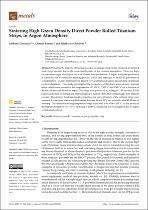 ResearchSpace
ResearchSpace
Sintering high green density direct powder rolled titanium strips, in argon atmosphere
JavaScript is disabled for your browser. Some features of this site may not work without it.
- ResearchSpace
- →
- Research Publications/Outputs
- →
- Journal Articles
- →
- View Item
| dc.contributor.author |
Govender, A

|
|
| dc.contributor.author |
Bemont, C

|
|
| dc.contributor.author |
Chikosha, Silethelwe

|
|
| dc.date.accessioned | 2023-02-26T20:27:00Z | |
| dc.date.available | 2023-02-26T20:27:00Z | |
| dc.date.issued | 2021-06 | |
| dc.identifier.citation | Govender, A., Bemont, C. & Chikosha, S. 2021. Sintering high green density direct powder rolled titanium strips, in argon atmosphere. <i>Metals, 11(6), 936.</i> http://hdl.handle.net/10204/12634 | en_ZA |
| dc.identifier.issn | 2075-4701 | |
| dc.identifier.uri | https://doi.org/10.3390/met11060936 | |
| dc.identifier.uri | http://hdl.handle.net/10204/12634 | |
| dc.description.abstract | Presently, the majority of titanium powder metallurgy components produced are sintered under high vacuum due to the associated benefits of the vacuum atmosphere. However, high-vacuum sintering is a batch process, which limits daily production. A higher daily part production is achievable via a continuous sintering process, which uses argon gas to shield the part from air contamination. To date, there has been limited work published on argon gas sintering of titanium in short durations. This study investigated the properties of thin high green density titanium strips, which were sintered at the temperatures of 1100 °C, 1200 °C and 1300 °C for a duration of 30 min, 60 min and 90 min in argon. The strips were produced by rolling of -45 µm near ASTM (American Society for Testing and Materials) grade 3 hydride–dehydride commercially pure titanium powder. The density, hardness, tensile properties and microstructure of the sintered strips were assessed. It was found that near-full densities, between 96 and 99%, are attainable after 30–90 min of sintering. The optimum sintering temperature range was found to be 1100–1200 °C, as this produced the highest elongation of 4–5.5%. Sintering at 1300 °C resulted in lower elongation due to higher contaminant pick-up. | en_US |
| dc.format | Fulltext | en_US |
| dc.language.iso | en | en_US |
| dc.relation.uri | https://www.mdpi.com/2075-4701/11/6/936 | en_US |
| dc.relation.uri | Powder Mettalurgy Technologies | en_US |
| dc.source | Metals, 11(6), 936 | en_US |
| dc.subject | Titanium powder metallurgy | en_US |
| dc.subject | High-vacuum sintering | en_US |
| dc.subject | Argon | en_US |
| dc.subject | Sintered strips | en_US |
| dc.title | Sintering high green density direct powder rolled titanium strips, in argon atmosphere | en_US |
| dc.type | Article | en_US |
| dc.description.pages | 21 | en_US |
| dc.description.note | Copyright: © 2021 by the authors. Licensee MDPI, Basel, Switzerland. This article is an open access article distributed under the terms and conditions of the Creative Commons Attribution (CC BY) license (https://creativecommons.org/licenses/by/4.0/). | en_US |
| dc.description.cluster | Manufacturing | en_US |
| dc.identifier.apacitation | Govender, A., Bemont, C., & Chikosha, S. (2021). Sintering high green density direct powder rolled titanium strips, in argon atmosphere. <i>Metals, 11(6), 936</i>, http://hdl.handle.net/10204/12634 | en_ZA |
| dc.identifier.chicagocitation | Govender, A, C Bemont, and Silethelwe Chikosha "Sintering high green density direct powder rolled titanium strips, in argon atmosphere." <i>Metals, 11(6), 936</i> (2021) http://hdl.handle.net/10204/12634 | en_ZA |
| dc.identifier.vancouvercitation | Govender A, Bemont C, Chikosha S. Sintering high green density direct powder rolled titanium strips, in argon atmosphere. Metals, 11(6), 936. 2021; http://hdl.handle.net/10204/12634. | en_ZA |
| dc.identifier.ris | TY - Article AU - Govender, A AU - Bemont, C AU - Chikosha, Silethelwe AB - Presently, the majority of titanium powder metallurgy components produced are sintered under high vacuum due to the associated benefits of the vacuum atmosphere. However, high-vacuum sintering is a batch process, which limits daily production. A higher daily part production is achievable via a continuous sintering process, which uses argon gas to shield the part from air contamination. To date, there has been limited work published on argon gas sintering of titanium in short durations. This study investigated the properties of thin high green density titanium strips, which were sintered at the temperatures of 1100 °C, 1200 °C and 1300 °C for a duration of 30 min, 60 min and 90 min in argon. The strips were produced by rolling of -45 µm near ASTM (American Society for Testing and Materials) grade 3 hydride–dehydride commercially pure titanium powder. The density, hardness, tensile properties and microstructure of the sintered strips were assessed. It was found that near-full densities, between 96 and 99%, are attainable after 30–90 min of sintering. The optimum sintering temperature range was found to be 1100–1200 °C, as this produced the highest elongation of 4–5.5%. Sintering at 1300 °C resulted in lower elongation due to higher contaminant pick-up. DA - 2021-06 DB - ResearchSpace DP - CSIR J1 - Metals, 11(6), 936 KW - Titanium powder metallurgy KW - High-vacuum sintering KW - Argon KW - Sintered strips LK - https://researchspace.csir.co.za PY - 2021 SM - 2075-4701 T1 - Sintering high green density direct powder rolled titanium strips, in argon atmosphere TI - Sintering high green density direct powder rolled titanium strips, in argon atmosphere UR - http://hdl.handle.net/10204/12634 ER - | en_ZA |
| dc.identifier.worklist | 24656 | en_US |





